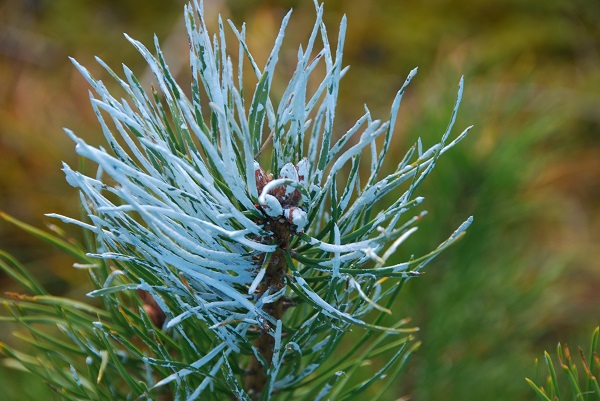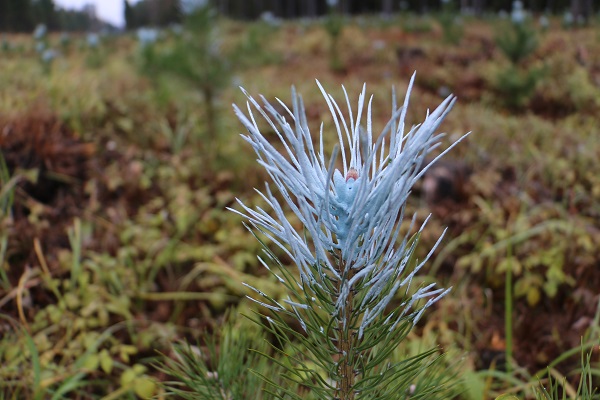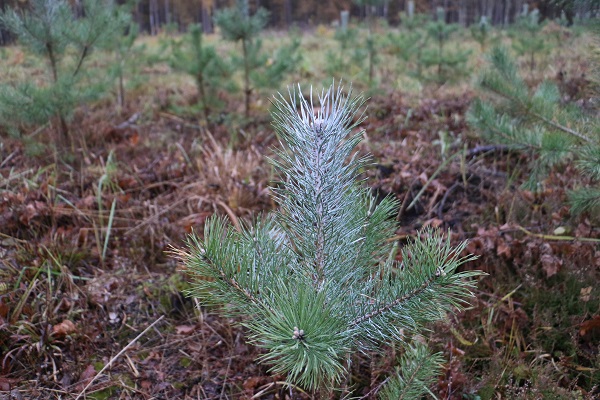LVM Keeps Protecting Young Trees against Damage Caused by Cervids
Autumn, when the active growing season of trees is over, is a suitable time for starting protection of young forest stands against possible damage caused by cervids during the autumn and winter months.
The range of remedies is extensive, but the choice of the most appropriate means of protection depends on the forest owner abilities and beliefs. For the protection of young forests stands, JSC "Latvia's State Forests" (LVM) mostly uses plant protection products or repellents with a smell or taste that animals dislike and that they can feel when biting off a seedling that has been treated with these repellents. Another option is spiral tree wraps or guards that are placed around the trunks of young pine-trees thus preventing tearing of the tree bark.
Photo: The central bud of a pine-tree covered with "Cervacol Extra" repellent
For trees of up to 1.5 metres in height, it is important to protect the central bud, because as soon as the tree top is bitten off, it is very likely that the tree will wither away and will not continue to grow. Trees of this height can be protected from cervid damage by repellents such as "Cervacol Extra" and "Wam Extra", which are applied by hand on the tree tops, or "Plantskydd" and "Trico", which are applied on trees using a hand sprayer.
Repellents "Cervacol Extra" and "Wam Extra" are ready-mixed pastas based on quartz sand and glue mixture. Once a cervid takes a bite of a tree that has been treated this way, it feels the presence of sand in its mouth, and it prevents the animals from damaging the rest of the protected trees.
Photo: A pine-tree treated with "Trico" repellent
Repellent "Trico" is a ready-to-use liquid based on sheep fat, while repellent "Plantskydd" must be mixed with water before use and formulated as directed by the manufacturer. Dried blood flour is the active ingredient of the "Plantskydd" repellent. These sprays have a specific odour that repels cervids from the protected area. LVM plans to protect close to 13 thousand hectares of young growths in 2018 using this type of plant protection products.
Days when the outside temperature is well above 0 °C and trees are dry are the most suitable time for the application of plant protection products. When used in such conditions, the repellents manage to dry after application and are able to perform their function throughout the winter months. It must be taken into account that after product application, it should not rain for at least two hours in order to allow the applied protective agent to dry completely. Failure to comply with this condition will prevent the repellent from drying and it will run down, thus not providing an adequate level of protection.
Photo: A pine-tree trunk protected with a spiral tree wrap
Once a pine-tree reaches a height of about 1.5 metres, there are no longer any needles at some places of the trunk and therefore cervids get increasingly interested in bark and side shoots rather than the central bud. To protect tree trunks from damage, both spray repellents and mechanical tree trunk protection means can be used.
In LVM young forest stands with an average height above 1.5 meters the target or future trees are protected with spiral tree wraps or using "Trico" repellent by spraying it onto the tree trunk between the whorls. The company plans to protect 1 600 hectares of young forest stands using this method in 2018.
All plant protection products are used in the young forest stands for several years in a row, thus protecting trees from damage and biting.
Since its foundation in 1999, LVM by implementing sustainable forest management has paid one billion euros to state and local government budgets. LVM's economic activities are carried out by maintaining and recovering forests, taking care of nature conservation, recreation opportunities and increasing timber volumes, as well as investing in expanding the forest land and developing forest infrastructure - renovation of drainage systems and forest road construction. The volume of timber in the forests managed by LVM increases by 12 million cubic metres annually.





